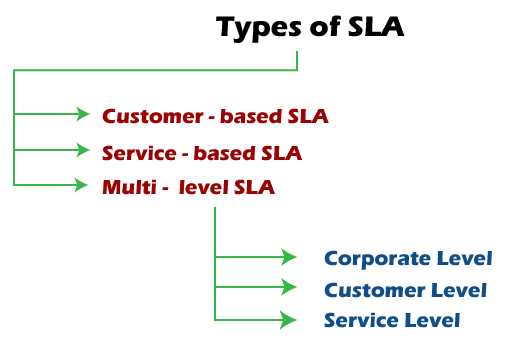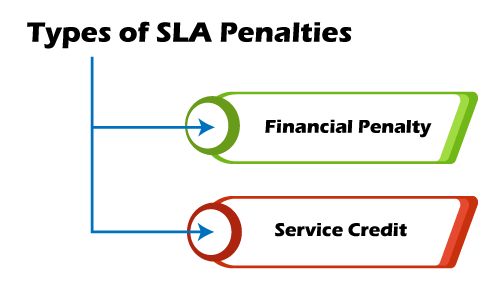What is an SLA?A service-level agreement (SLA) is a commitment between a service provider and a client. Particular aspects of the service, such as quality, availability, responsibilities are agreed upon between the service provider and the service user. It defines:
The most common component of an SLA is that the services should be provided to the customer as agreed upon in the contract. It is a critical component of any technology vendor contract. For example, Internet service providers will commonly include service level agreements within the terms of their contracts with customers to define the level of service being sold in plain language terms. Usually, SLAs are between companies and external suppliers, but they may also be between two departments within a company. In this case, the SLA will typically have a technical definition in mean time between failures (MTBF), mean time to repair or mean time to recovery (MTTR), identifying which party is responsible for reporting faults or paying fees, responsibility for various data rates, throughput, jitter, or similar measurable details. The Service Level Agreement includes:
Types of SLAThe selection of the types of SLA in an organization depends on many significant aspects. 
While some are targeted at individual customer groups, others discuss issues relevant to entire companies. This is because the needs of one user differ from another. Here are some types of SLAs used by businesses today and how each one is utilized for specific situations: 1. Customer-based SLA This type of agreement is used for individual customers and comprises all relevant services that a client may need while leveraging only one contract. It contains details regarding the type and quality of service that has been agreed upon. For example, a telecommunication service includes voice calls, messaging, and internet services, but all exist under a single contract. 2. Service-based SLA This SLA is a contract that includes one identical type of service for all of its customers. Because the service is limited to one unchanging standard, it is more straightforward and convenient for vendors. For example, using a service-based agreement regarding an IT helpdesk would mean that the same service is valid for all end-users that sign the service-based SLA. 3. Multi-level SLA This agreement is customized according to the needs of the end-user company. It allows the user to integrate several conditions into the same system to create a more convenient service. This type of SLA can be divided into the following subcategories:
Components of SLAAn SLA highlights what the client and the service provider want to achieve with their cooperation and outlines the obligations of the participants, the expected performance level, and the results of cooperation. An SLA usually has a defined duration time that is provided in the document. The services that the provider agrees to deliver are often described in detail to avoid misunderstanding, including procedures of performance monitoring, assessment, and troubleshooting. Here are the following components necessary for a good agreement:
Common Metrics of SLAService-level agreements can contain numerous service-performance metrics with corresponding service-level objectives. A common case in IT-service management is a call center or service desk. Metrics commonly agreed to in these cases include:
Uptime is also a common metric used for data services such as shared hosting, virtual private servers, and dedicated servers. Standard agreements include the percentage of network uptime, power uptime, number of scheduled maintenance windows, etc. Many SLAs track to the ITIL specifications when applied to IT services. Types of SLA PenaltiesA natural reply to any violation is a penalty. An SLA penalty depends on the industry and business. Here are the two most common SLA penalty types. 
1. Financial penalty This kind of penalty requires a vendor to pay the customer compensation of damages equal to the one written in the agreement. The amount will depend on the extent of a violation and damage and may not fully reimburse what a customer paid for the eCommerce service or eCommerce support.
2. Service credit In this case, a service provider will have to provide a customer with complimentary services for a specific time. To avoid any confusion or misunderstanding between the two parties in SLA violation, such penalties must be clearly articulated in the agreement. Otherwise, they won't be legitimate.
These penalties must be specified in the language of the SLA, or they won't be enforceable. In addition, some customers may not think the service credit or license extension penalties are adequate compensation. They may question the value of continuing to receive a vendor's services that cannot meet its quality levels. Consequently, it may be worth considering a combination of penalties and including an incentive, such as a monetary bonus, for more than satisfactory work. Revising and Changing an SLASince business requirements are subject to change, it's important to revise an SLA regularly. It will help to always keep the agreement in line with the business's service level objectives. The SLA should be revised when changes of the following occur:
The contract should have a detailed plan for its modification, including change frequency, change procedures, and changelog. 1. SLA Calculation SLA assessment and calculation determine a level of compliance with the agreement. There are many tools for SLA calculation available on the internet. 2. SLA uptime Uptime is the amount of time the service is available. Depending on the type of service, a vendor should provide minimum uptime relevant to the average customer's demand. Usually, a high uptime is critical for websites, online services, or web-based providers as their business relies on its accessibility. 3. Incident and SLA violations This calculation helps determine the extent of an SLA breach and the penalty level foreseen by the contract. The tools usually calculate a downtime period during which service wasn't available, compare it to SLA terms and identify the extent of the violation. 4. SLA credit If a service provider fails to meet the customer's expectations outlined in the SLA, a service credit or other type of penalty must be given as a form of compensation. A percentage of credit depends directly on the downtime period, which exceeded its norm indicated in a contract. Service Level ManagementService level management is the process of managing SLAs that helps companies to define, document, monitor, measure, report, and review the performance of the provided services. The professional SLA management services should include:
An SLA is a preventive means to establish a transparent relationship between both parties involved and build relationships in the cooperation. Such a document is fundamental to a successful collaboration between a client and a service provider.
Next TopicWhat is Face Value
|
 For Videos Join Our Youtube Channel: Join Now
For Videos Join Our Youtube Channel: Join Now
Feedback
- Send your Feedback to [email protected]
Help Others, Please Share










